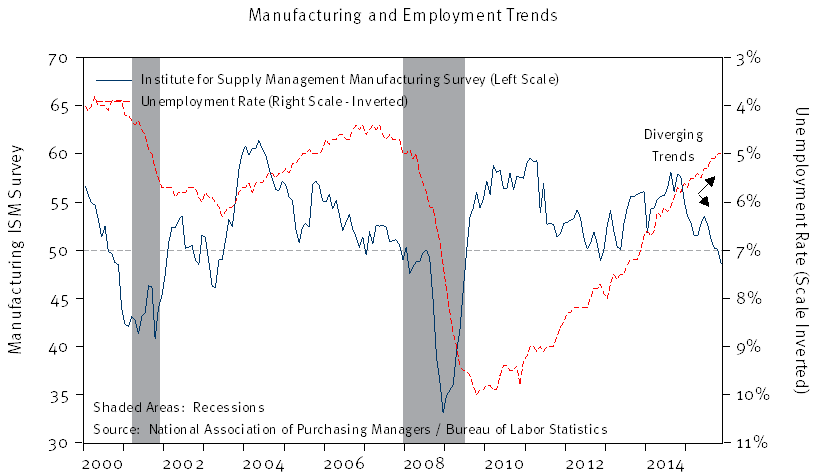International Concerns Out of the Gate
This morning’s equity market sell-off follows a 7% decline in China’s Shanghai Stock Exchange Composite Index. The decline tripped circuit breakers and led to a closure of China’s exchanges. A weak read on China’s official Purchasing Manager’s Index (PMI) and increased tension between Saudi Arabia and Iran are contributing to the negative tone. China’s PMI remained below 50 for a fifth month and points to continued weakness in China’s manufacturing sector. Protests and an attack on Saudi Arabia’s embassy in Tehran, precipitated by Saturday’s announcement of Saudi Arabia’s execution of 47 prisoners, including a well-known Shiite cleric, adds to investor concerns. The embassy attack led to the expulsion of Iranian diplomats from Saudi Arabia.
Against this backdrop, we see that the U.S. economy continues to show slow but steady economic progress. Data released this week will allow financial markets to gauge the strength of both the manufacturing sector (ISM Manufacturing Survey) as well as the labor market (December Employment Report) as we begin 2016. Now that the Federal Reserve (Fed) has raised the Fed Funds rate to 0.25% and has made it abundantly clear that any future rate increases would be “data dependent,” expect these two reports to garner more interest than previous prints.
The chart below tracks the history of both the ISM Manufacturing Survey and the BLS Unemployment Rate from the beginning of the new millennium to the end of last year. Though the unemployment rate has come down from its high of 10.0% to 5.0% in December, the manufacturing sector (and the economy as a whole) ended 2015 with a whimper. The Fed should continue to monitor this report to help guide their future decision making.
ASSET ALLOCATION PORTFOLIO POSTURE
Strategic allocations are set to reflect our long-run forecasts for key asset classes. We invite you to read our latest annual report, Viewpoint 2016, by clicking here.
Kevin Caron, Portfolio Manager
Chad Morganlander, Portfolio Manager
Matthew Battipaglia, Analyst
Suzanne Ashley, Junior Analyst
Disclosures
The information contained herein has been prepared from sources believed to be reliable but is not guaranteed by us and is not a complete summary or statement of all available data, nor is it considered an offer to buy or sell any securities referred to herein. Opinions expressed are subject to change without notice and do not take into account the particular investment objectives, financial situation, or needs of individual investors. There is no guarantee that the figures or opinions forecasted in this report will be realized or achieved. Employees of Stifel, Nicolaus & Company, Incorporated or its affiliates may, at times, release written or oral commentary, technical analysis, or trading strategies that differ from the opinions expressed within. Past performance is no guarantee of future results. Indices are unmanaged, and you cannot invest directly in an index.
Asset allocation and diversification do not ensure a profit and may not protect against loss. There are special considerations associated with international investing, including the risk of currency fluctuations and political and economic events. Investing in emerging markets may involve greater risk and volatility than investing in more developed countries. Due to their narrow focus, sector-based investments typically exhibit greater volatility. Small company stocks are typically more volatile and carry additional risks, since smaller companies generally are not as well established as larger companies. Property values can fall due to environmental, economic, or other reasons, and changes in interest rates can negatively impact the performance of real estate companies. When investing in bonds, it is important to note that as interest rates rise, bond prices will fall. High-yield bonds have greater credit risk than higher quality bonds. The risk of loss in trading commodities and futures can be substantial. You should therefore carefully consider whether such trading is suitable for you in light of your financial condition. The high degree of leverage that is often obtainable in commodity trading can work against you as well as for you. The use of leverage can lead to large losses as well as gains.
The WCA Fundamental Conditions Barometer measures the breadth of changes to a wide variety of fundamental data. The barometer measures the proportion of indicators under review that are moving up or down together. A barometer reading above 50 generally indicates a more bullish environment for the economy and equities, and a lower reading implies the opposite. Quantifying changes this way helps us incorporate new facts into our near-term outlook in an objective and unbiased way. More information on the barometer is found in our latest quarterly report, available at www.washingtoncrossingadvisors.com/insights.html.
The Shanghai Stock Exchange Composite Index (SSE Composite Index) is a stock market index of all stocks (A shares and B shares) that are traded at the Shanghai Stock Exchange. The index is calculated using a Paasche weighted composite price index formula, meaning the index calculation is based on a base period on a specific base day (the total market capitalization of all component stocks on that day). The base day is December 19, 1990, the Base Value is 100, and the formula is: Current index = Current total market cap of constituents X Base Value / Base Period.




